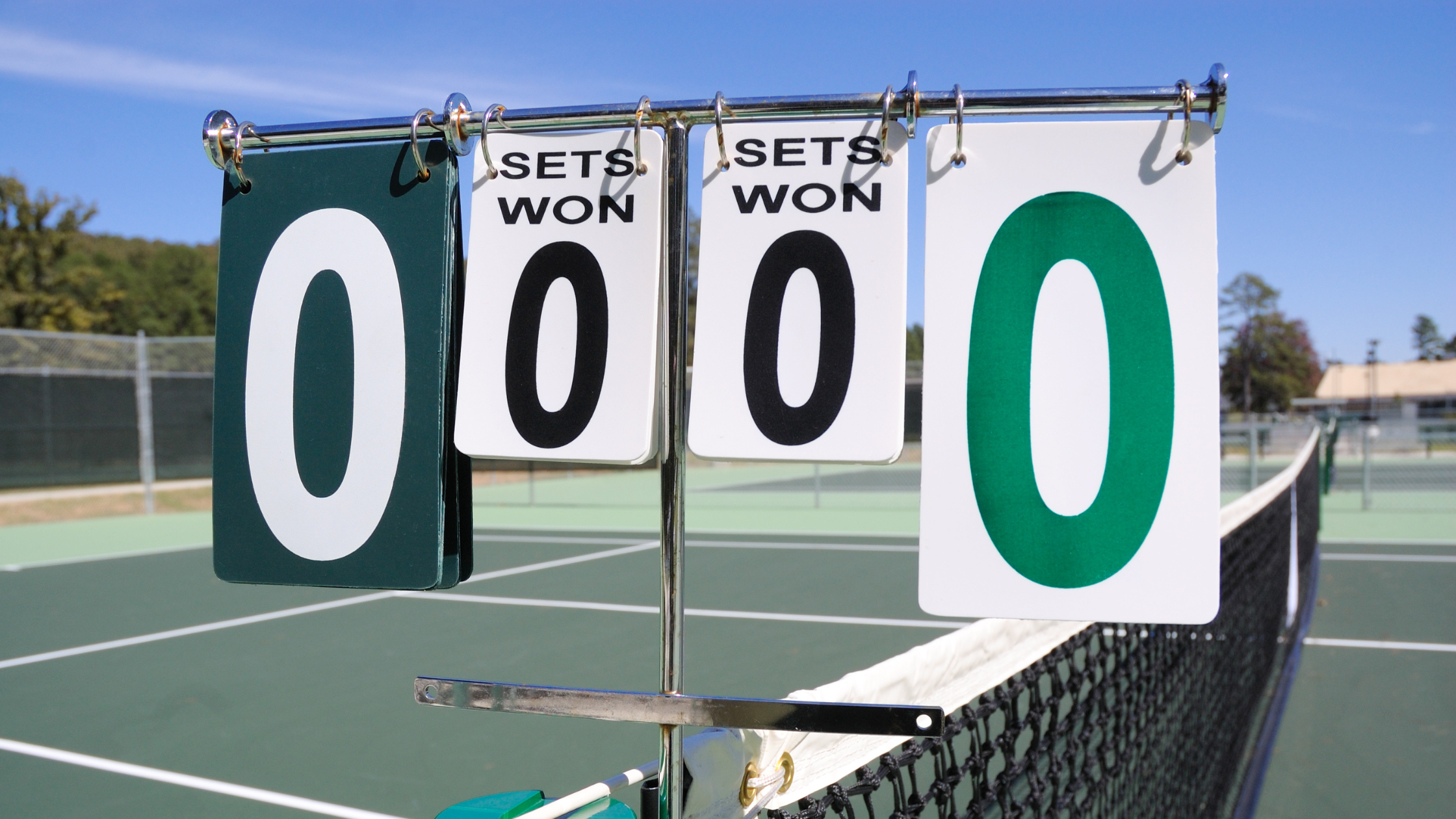Tennis is a popular and exciting sport that can be enjoyed by people of all ages and skill levels. However, if you are new to tennis, you may find the scoring system a bit confusing and intimidating. How do you keep track of points, games, sets, and matches? What do terms like love, deuce, and advantage mean? How do you know who is serving and who is receiving?
In this blog post, we will explain the basics of tennis scoring and help you understand how to score a tennis match. We will cover the following topics:
- The structure of a tennis match
- The point system in tennis
- The game system in tennis
- The set system in tennis
- The match system in tennis
- The tiebreak system in tennis
- The common terms and phrases in tennis scoring
By the end of this blog post, you will be able to score a tennis match with confidence and enjoy the game more. Let’s get started!
The Structure of a Tennis Match
A tennis match is composed of three main elements: points, games, and sets. A point is the smallest unit of scoring in tennis, a game is a collection of points, and a set is a collection of games. A match is usually played to the best of three or five sets, depending on the tournament or event.
A tennis match is played on a rectangular-shaped court, which can be made of different surfaces such as grass, clay, or hard court. The court is divided by a net into two equal halves, and each half has two service boxes and two baselines. The players stand on opposite sides of the net and use a stringed racquet to hit a ball back and forth over the net. The ball must land within the boundaries of the court to be valid.
The player who starts the match by hitting the ball over the net is called the server, and the player who receives the ball is called the receiver. The server and receiver alternate every game, and the side of the court also changes every odd-numbered game. The server must hit the ball into the service box diagonally opposite to him or her. If the server misses the service box, it is called a fault. The server has two chances to serve correctly for each point. If both serves are faults, it is called a double fault and the receiver wins the point.
The receiver must return the ball over the net before it bounces twice on his or her side of the court. The players then continue to rally until one of them fails to return the ball correctly or commits an error. Some common errors are:
- Hitting the ball outside the court boundaries
- Hitting the net with the ball or racquet
- Touching the net or any part of the opponent’s court with any part of the body or racquet
- Hitting the ball twice or carrying it with the racquet
The player who wins the point adds it to his or her score for that game. The player who wins enough points to win a game adds it to his or her score for that set. The player who wins enough games to win a set adds it to his or her score for that match. The player who wins enough sets to win the match is declared the winner.
The Point System in Tennis
Tennis has a unique point system that differs from most other sports. Instead of counting points as 1, 2, 3, etc., tennis uses 0, 15, 30, and 40 as point values. Here is how it works:
- When both players have zero points, it is called love-all.
- When one player has 15 points and the other has zero points, it is called 15-love or love-15, depending on who is leading.
- When one player has 30 points and the other has zero points, it is called 30-love or love-30.
- When one player has 40 points and the other has zero points, it is called 40-love or love-40.
- When both players have 15 points, it is called 15-all.
- When both players have 30 points, it is called 30-all.
- When both players have 40 points, it is called deuce.
The origin of these point values is not clear, but some possible explanations are:
- They are derived from medieval French coins that were worth 15 deniers each.
- They are based on the four quarters of an hour (15 minutes each) on a clock face.
- They are related to the angles (15 degrees each) formed by a compass rose.
To win a game, a player must win at least four points and be ahead by at least two points. For example:
- If a player has 40 points and the other has 30 points or less, and wins one more point, he or she wins the game.
- If a player has 40 points and the other has 40 points, and wins two more points in a row, he or she wins the game.
However, if both players have 40 points, the game is not over yet. This situation is called deuce, and it means that the game is tied. To break the tie, one player must win two consecutive points. The first point after deuce is called advantage, and the second point is called game. For example:
- If the server wins the point after deuce, it is called advantage-in or ad-in.
- If the receiver wins the point after deuce, it is called advantage-out or ad-out.
- If the player with the advantage wins the next point, he or she wins the game.
- If the player with the advantage loses the next point, the score goes back to deuce.
This process repeats until one player wins two points in a row after deuce and wins the game.
The Game System in Tennis
A set is a collection of games that are played until one player wins at least six games and is ahead by at least two games. For example:
- If a player wins six games and the other wins four games or less, he or she wins the set by a score of 6-4 or 6-3 or 6-2 or 6-1 or 6-0.
- If a player wins six games and the other wins five games, he or she must win one more game to win the set by a score of 7-5.
- If both players win six games each, they must play a tiebreak game to decide the winner of the set by a score of 7-6.
The order of serving and receiving changes every game. The player who served first in the previous game becomes the receiver in the next game, and vice versa. The side of the court also changes every odd-numbered game. For example:
- In the first game of a set, Player A serves from the right side of the court to Player B’s left service box.
- In the second game of a set, Player B serves from the left side of the court to Player A’s right service box.
- In the third game of a set, Player A serves from the left side of the court to Player B’s right service box.
- In the fourth game of a set, Player B serves from the right side of the court to Player A’s left service box.
And so on.
The Set System in Tennis
A match is a collection of sets that are played until one player wins at least two sets (in best-of-three matches) or three sets (in best-of-five matches). For example:
- If a player wins two sets and loses one set or none, he or she wins the match by a score of 2-1 or 2-0 (in best-of-three matches).
- If a player wins three sets and loses one set or none, he or she wins the match by a score of 3-1 or 3-0 (in best-of-five matches).
The order of serving and receiving changes every set. The player who served first in the previous set becomes the receiver in the next set, and vice versa. The side of the court also changes every odd-numbered set. For example:
- In the first set of a match, Player A serves first from the right side of the court.
- In the second set of a match, Player B serves first from the left side of the court.
- In the third set of a match, Player A serves first from the left side of the court.
And so on.
The Tiebreak System in Tennis
A tiebreak is a special game that is played when both players have won six games each in a set. The purpose of a tiebreak is to decide who wins the set by a score of 7-6. A tiebreak is different from a regular game in several ways:
- Instead of using 0, 15, 30, and 40 as point values, a tiebreak uses 1, 2, 3, etc.
- Instead of serving for an entire game, each player serves for two points at a time, alternating after every four points.
- Instead of serving from one side of the court for an entire game, each player serves from both sides of the court for each point.
- Instead of changing sides every odd-numbered game, each player changes sides every six points.
Here is how it works:
- The player who served in the previous game becomes the receiver in the first point of the tiebreak. He or she chooses which side of the court to receive from.
- The player who received in the previous game becomes the server in the first point of the tiebreak. He or she serves from the right side of the court to the receiver’s left service box.
- The server then serves the second point from the left side of the court to the receiver’s right service box.
- The players then switch roles. The receiver becomes the server and serves two points, starting from the right side of the court.
- The players continue to serve and receive two points at a time, alternating after every four points, until one of them wins at least seven points and is ahead by at least two points. For example:
- If a player has seven points and the other has six points or less, he or she wins the tiebreak by a score of 7-6 or 7-5 or 7-4 or 7-3 or 7-2 or 7-1 or 7-0.
- If a player has seven points and the other has seven points, he or she must win one more point to win the tiebreak by a score of 8-7.
- If both players have eight points each, they must play another point to break the tie. The player who wins this point wins the tiebreak by a score of 9-8.
- The player who wins the tiebreak wins the set by a score of 7-6.
The order of serving and receiving changes every point in a tiebreak. The player who served in the last point of the previous game becomes the receiver in the first point of the tiebreak, and vice versa. The side of the court also changes every six points in a tiebreak. For example:
- In the first point of a tiebreak, Player A receives from Player B’s right side of the court.
- In the second point of a tiebreak, Player A serves from his or her left side of the court to Player B’s right service box.
- In the third point of a tiebreak, Player A serves from his or her right side of the court to Player B’s left service box.
- In the fourth point of a tiebreak, Player B serves from his or her left side of the court to Player A’s right service box.
- In the fifth point of a tiebreak, Player B serves from his or her right side of the court to Player A’s left service box.
- In the sixth point of a tiebreak, Player A receives from Player B’s left side of the court.
And so on.
The Common Terms and Phrases in Tennis Scoring
Tennis scoring has some unique terms and phrases that you may hear during a match. Here are some of them and what they mean:
- Ace: A serve that is so good that the receiver cannot touch it with his or her racquet. The server wins the point automatically.
- Double fault: A serve that misses both attempts to hit the service box. The receiver wins the point automatically.
- Let: A serve that touches the net but still lands in the service box. The serve is replayed without changing the score.
- Fault: A serve that misses the service box on the first attempt. The server has one more chance to serve correctly.
- Break: A game that is won by the receiver. This gives him or her an advantage over the server in terms of scoring.
- Break point: A point that, if won by the receiver, will result in a break. There can be multiple break points in a game depending on how many points are needed to win it.
- Hold: A game that is won by the server. This maintains his or her advantage over the receiver in terms of scoring.
- Hold point: A point that, if won by the server, will result in a hold. There can be multiple hold points in a game depending on how many points are needed to win it.
- Game point: A point that, if won by either player, will result in a game. There can be multiple game points in a game depending on how many points are needed to win it.
- Set point: A point that, if won by either player, will result in a set. There can be multiple set points in a set depending on how many games are needed to win it.
- Match point: A point that, if won by either player, will result in a match. There can be multiple match points in a match depending on how many sets are needed to win it.
Conclusion
We hope this blog post has helped you understand how to score a tennis match. Tennis scoring may seem complicated at first, but once you get the hang of it, you will find it easy and fun. Tennis is a great sport that can improve your physical and mental health, as well as your social skills.
Thank you for reading this blog post. If you have any questions or feedback, please leave a comment below. We would love to hear from you. Happy scoring!








No Comment! Be the first one.